May 12, 2017
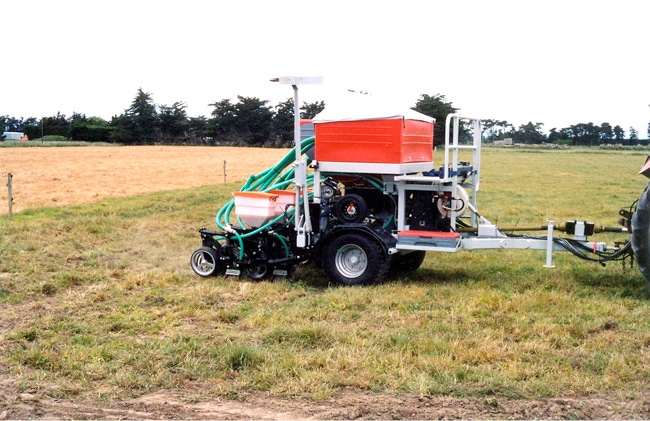
During a “Future of No-till” presentation at Western Illinois University, New Zealander John Baker discussed how current no-till practices have only achieved about 50% of its potential conservation agriculture capability.
Baker, who initiated a research and development program at New Zealand’s Massey University in 1967, aimed to identify and eliminate issues in no-till by studying soil science and the impact of no-till seeding openers.
Baker says in the past, the focus for “conservation agriculture” has been largely on achieving visible objects such as reducing the severity and nature of soil disturbance, leaving as much crop residue as possible on the soil surface, utilizing cover crops and controlling wheel traffic as much as possible.
The result has been the development and implementation of practices such as minimum till, strip till, vertical tillage and no-till. In Baker’s view, all of these practices collectively have progressed conservation agriculture to achieving about 50% of its true objectives, which are:
To make food production truly sustainable for the first time in history
To increase productivity from the declining total area of arable land that is left in the world, and
To improve the environment we live in including air and water quality and greenhouse gas (GHG) emissions.
Remaining silver bullets
What is now needed is to focus on the remaining 50% of conservation agriculture’s objectives. Baker says we need to maximize the two invisible “silver bullet” assets offered by low-disturbance no-tillage – water vapor and carbon. And only true low-disturbance no-tillage is capable of doing this, he adds.
After 30 years of work refining openers for seeding, he left the university and formed Baker No-Tillage Ltd. Since 1998, Baker’s company has successfully marketed Cross Slot low-disturbance no-tillage machines for small grain production in 21 countries across the globe, with particular emphasis on Australia, Europe and North America.
Now, Baker and his team are currently developing a Cross Slot corn planter.
In his presentation, Baker highlighted how his research ranked no-till openers on 29 diff functions, but there are five key functions:
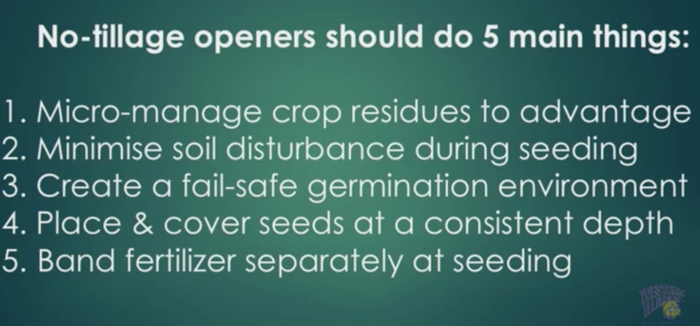
Micro-manage crop residues to advantage.
Minimize soil disturbance during seeding. Baker says Don Reicosky, soil scientist, Emeritus, North Central Soil Conservation Research Lab in Morris, Minnesota, really started this effort to understand that when you disturb soil, you oxidize the mobile carbon in the soil which escapes into the atmosphere as CO2. Twenty percent of total CO2 comes from the soil due to continuous tillage around the globe.
Create a fail-safe germination environment.
Place and cover seeds at a consistent depth. More difficult in no-till conditions.
Band fertilizer separately at seeding.
Baker and his colleagues researched numerous no-till drill openers. The three slots they started comparing: V shape (double-disk), U shape and inverted-T shape (shank with wings).
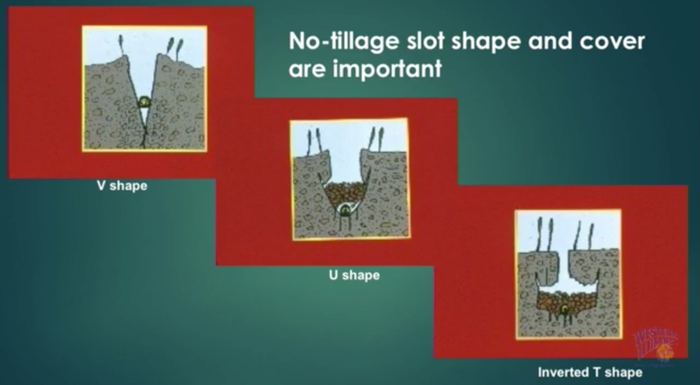
“We created a winged inverted-T opener, which research proved to increase germination to 77%, from 24% (hoe opener/double disk opener). Initially, we didn’t know why. After more research, we learned that the pore spaces contain 100% relative humidity. However, when cultivated, we lost that humidity. That’s when we realized it is a silver bullet.”
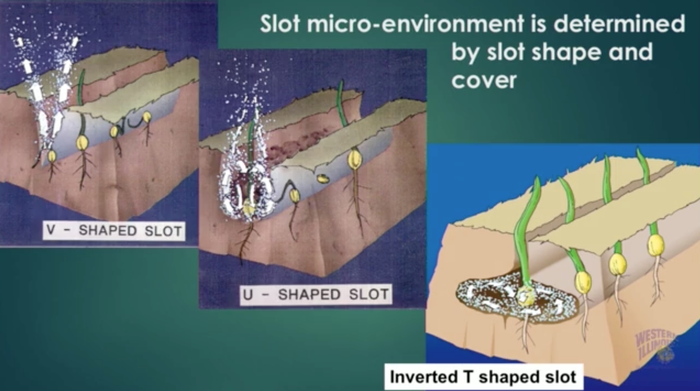
Further research measured water vapor retention in the slot (see image above), and the Inverted-T slot retained much more relative humidity (microclimate) to increase germination. Baker says It takes a little longer to germinate from the inverted slot (seed on one side, fertilizer on the other side, flap closes on top). “You don’t actually need soil for a seed to germinate, just air and water vapor. Soil usually delivers water to the seed. But if you have water vapor in the slot, then soil moisture is less critical. Works same with monocots as dicots. The flap cover traps the humidity.”
Baker isn’t shy about his views on corn planters. “There is nothing worse than a double disc opener, biologically, to seed into no-till. It’s bad news. Why they are used on corn planters, I don’t know. “
Water vapor value
Water vapor, in the form of the air humidity within undisturbed soil and decaying residues, has a strong influence on:
Seed germination in untilled soils. When the seeded slots are specifically covered by surface residues – because undisturbed soil contains 99-100% humid air – this humidity is capable of germinating seeds in the absence of available liquid soil water. When soil is tilled, soil humidity plays only a minimal role because tillage allows it to escape from the soil.
Survival of germinated seedlings prior to emergence. When residues cover the seeded slots, sub-surface seedlings can survive for several weeks cocooned in a humid atmosphere in untilled soils. This can make the difference between stand success and failure.
Survival and proliferation of soil microbes and biology. Tillage and all soil disturbance destroys soil biology as well as discharging soil water vapor into the atmosphere. And most microbes need a humid soil atmosphere.
Decomposition of surface residues. The microbial decomposition process itself creates a humid and warmer environment within decaying residues on the surface of the ground, which makes their decay largely self-perpetuating in conditions that do not otherwise favor decomposition.
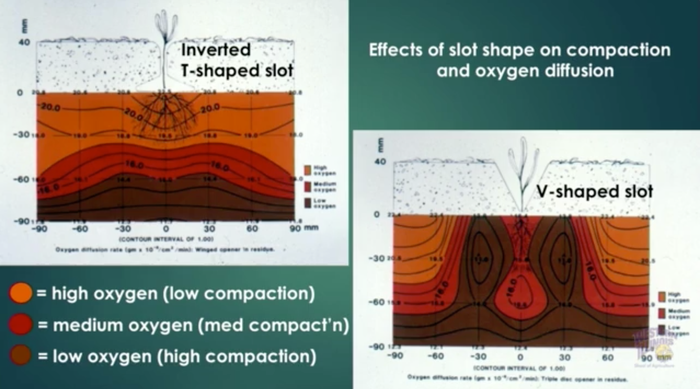
The above slide shows research comparing the effects of slot shape on compaction and oxygen diffusion. Baker shows that no-till drill openers can influence aeration around seeds and roots in wet soils. With no-till, a slot wall is created between the slot zone and the undisturbed soil alongside. If these slot walls are nearly vertical (and even worse are compacted or at least smeared) they may restrict early root growth to the extent that in severe cases the roots never leave the slot zone and the crop performs poorly.
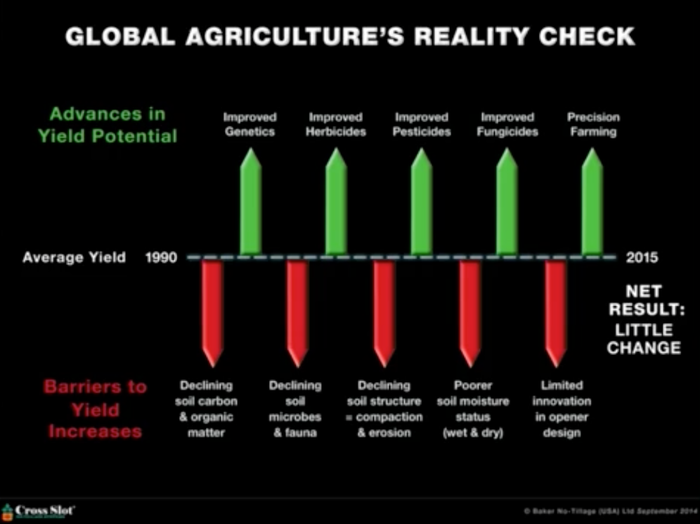
Baker hightlighted a global reality check on yield (see above). “We’ve had improvements in genetics, herbicides, insecticides, fungicides and precision farming from 1990 to 2015. But, yield increases have been held down by soil barriers: declining soil carbon and organic matter; declining soil microbes and fauna; declining soil structure, compaction and erosion; poor soil moisture status due to reduced OM (wet and dry); and limited innovation in opener design. The end result is no change, unless we focus on soil organic matter and carbon.”
Saving carbon
Minimizing carbon discharge from the soil and decaying organic matter and maximizing carbon sequestration from decaying surface organic matter are complimentary objectives:
All soil disturbance oxidizes soil carbon into CO2, which escapes into the atmosphere (even in-row disturbance does this, which is a disadvantage of strip till and vertical tillage practices).
Carbon is sequestered into the soil from decaying organic matter and physical incorporation by soil biology, hence the importance of a continuum of available carbon sources such as crop residues and terminated cover crops.
Certainly, the residue decomposition process involves respiration by the microbes involved and this is also lost to the atmosphere as CO2 – but there is a significant net gain of carbon by the soil from the products of the decomposition. By contrast, burying surface organic matter by tillage usually discharges more carbon into the atmosphere from the soil disturbance than is gained from the buried material.
Baker says it took 20 years to develop the Cross Slot, which he claims removes these barriers to yield increases. “You need a machine that can universally do all these things.”
Critical functions of no-tillage openers and drills
Handle all and any type of residues, wet or dry.
70+ percent retention of residues post-driklling
Minimize in-slot soil disturbance.
Trap moisture vapor in slot in dry soils.
Avoid placing seed in residue hairpins.
Maximize in-slot aeration in wet soils.
Avoid in-slot compaction or smearing/crusting.
Maximize soil-to-seed contact.
Self close the slot.
Mitigate post-drilling slot shrinkage.
Faithfully follow the soil surface.
Have at least 300 mm of vertical opener travel.
Consistent downforce throughout the entire range.
Accurately control seeding depth at 12-15 mm with shallow seeds like canola.
Auto-adjust the downforce to match soil harness.
Simultaneous banding of fertilizer without burn.
Effective with high rates of high-analysis fertilizers.
Handle sticky soils.
Handle stony soils.
Avoid bringing stones to the surface.
Unaffected by hillsides.
Minimal adjustments for different conditions.
Maintain critical functions at high speeds.
Self-adjustment of wearing components.
Minimum 10-year design life.
Low wear of soil-engaging parts.
Wear components cheap and easy to replace.
Minimal draft required from the tractor.
Always have a positive impact on crop yield.
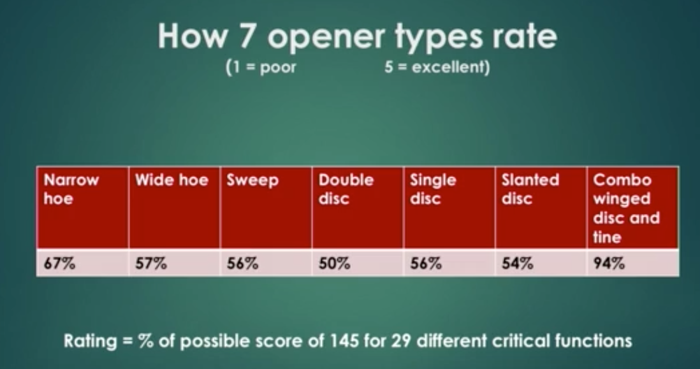
Given these 29 critical functions, research rated all 7 openers by each attributes (scored 1-5) and developed an overall rating as a percentage of a perfect score (see above):
Narrow hoe – 67%
Wide hoe – 57%
Sweep – 56%
Double disc – 50%
Single disc – 56%
Slanted disc – 54%
Combo winged disc and tine (inverted T) – 94%
(see individual ratings here on page 31 of this Q&A PDF)
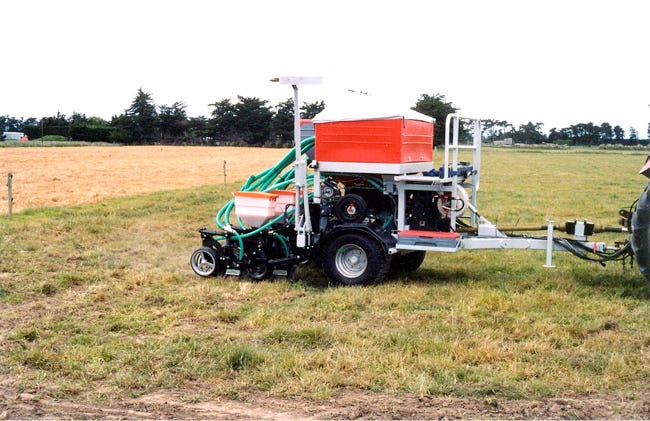
Baker didn’t share any information about their corn planter during his presentation, but their website shows this small 4-row prototype Cross Slot precision maize planter in New Zealand (12-row folding Cross Slot planters are in the course of development). Will keep you posted when we obtain more information.
Further information:
Baker and colleagues published a book of their science over 30 years: “No-tillage Seeding in Conservation Agriculture.”
About the Author(s)
You May Also Like






